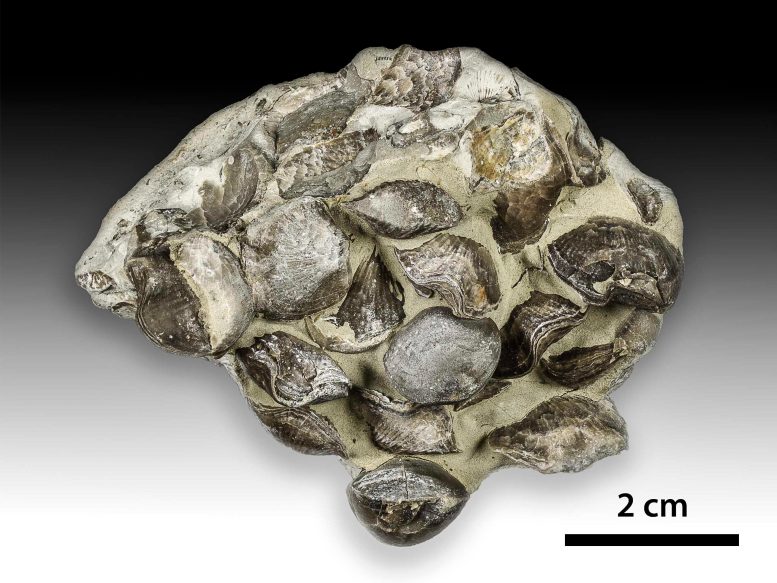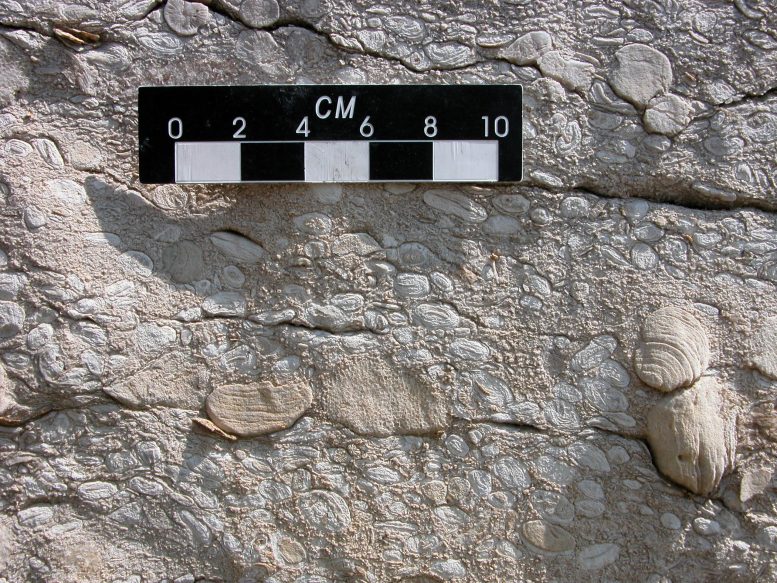
Detail images of fossils from the Ordovician Period outcrop on Anticosti Island, Quebec, Canada. Credit: André Desrochers, University of Ottawa
A team of researchers publish a new study exploring the cause of the Late Ordovician mass extinction.
We all know that the dinosaurs died in a mass extinction. But did you know that there were other mass extinctions? There are five most significant mass extinctions, known as the “big five,” where at least three-quarters of all species in existence across the entire Earth faced extinction during a particular geological period of time. With current trends of global warming and climate change, many researchers now believe we may be in a sixth.
Discovering the root cause of Earth’s mass extinctions has long been a hot topic for scientists, as understanding the environmental conditions that led to the elimination of the majority of species in the past could potentially help prevent a similar event from occurring in the future.
A team of scientists from Syracuse University’s Department of Earth and Environmental Sciences, the University of California, Berkeley and the University of California, Riverside, Université Bourgogne Franche-Comté, the University of New Mexico, the University of Ottawa, the University of Science and Technology of China and Stanford University recently co-authored a paper exploring the Late Ordovician mass extinction (LOME), which is the first, or oldest of the “big five (~445 million years ago).” Around 85% of marine species, most of which lived in shallow oceans near continents, disappeared during that time.

Detail images of fossils from the Ordovician Period outcrop on Anticosti Island, Quebec, Canada. Credit: André Desrochers, University of Ottawa
Lead author Alexandre Pohl, from UC Riverside (now a postdoctoral research fellow at Université Bourgogne Franche-Comté in Dijon, France) and his co-authors investigated the ocean environment before, during, and after the extinction in order to determine how the event was brewed and triggered. The results from their study was published in the journal Nature Geoscience today (November 1, 2021).
To paint a picture of the oceanic ecosystem during the Ordovician Period, mass extinction expert Seth Finnegan, associate professor at UC Berkeley, says that seas were full of biodiversity. Oceans contained some of the first reefs made by animals, but lacked an abundance of vertebrates.
“If you had gone snorkeling in an Ordovician sea you would have seen some familiar groups like clams and snails and sponges, but also many other groups that are now very reduced in diversity or entirely extinct like trilobites, brachiopods, and crinoids,” says Finnegan.
Unlike with rapid mass extinctions, like the Cretaceous-Tertiary extinction event where dinosaurs and other species died off suddenly some 65.5 million years ago, Finnegan says LOME played out over a substantial period of time, with estimates between less than half a million to almost two million years.

Detail images of fossils from the Ordovician Period outcrop on Anticosti Island, Quebec, Canada. Credit: André Desrochers, University of Ottawa
One of the major debates surrounding LOME is whether lack of oxygen in seawater caused that period’s mass extinction. To investigate this question, the team integrated geochemical testing with numerical simulations and computer modeling.
Zunli Lu, professor of Earth and environmental sciences at Syracuse University, and his students took measurements of iodine concentration in carbonate rocks from that period, contributing important findings about oxygen levels at various ocean depths. The concentration of the element iodine in carbonate rocks serves as an indicator for changes in oceanic oxygen level in Earth’s history.
Their data, combined with computer modeling simulations, suggested that there was no evidence of anoxia – or lack of oxygen – strengthening during the extinction event in the shallow ocean animal habitat where most organisms lived, meaning that climate cooling that occurred during the Late Ordovician period combined with additional factors likely was responsible for LOME.
On the other hand, there is evidence that anoxia in deep oceans expanded during that same time, a mystery that cannot be explained by the classic model of ocean oxygen, climate modeling expert Alexandre Pohl says.
“Upper-ocean oxygenation in response to cooling was anticipated, because atmospheric oxygen preferentially dissolves in cold waters,” Pohl says. “However, we were surprised to see expanded anoxia in the lower ocean since anoxia in Earth’s history is generally associated with volcanism-induced global warming.”
They attribute the deep-sea anoxia to the circulation of seawater through global oceans. Pohl says that a key point to keep in mind is that ocean circulation is a very important component of the climatic system.
He was part of a team led by senior modeler Andy Ridgwell, professor at UC Riverside, whose computer modeling results show that climate cooling likely altered ocean circulation pattern, halting the flow of oxygen-rich water in shallow seas to the deeper ocean.
According to Lu, recognizing that climate cooling can also lead to lower oxygen levels in some parts of the ocean is a key takeaway from their study.
“For decades, the prevailing school of thoughts in our field is that global warming causes the oceans to lose oxygen and thus impact marine habitability, potentially destabilizing the entire ecosystem,” Lu says. “In recent years, mounting evidence point to several episodes in Earth’s history when oxygen levels also dropped in cooling climates.”
While the causes of Late Ordovician extinction have not been fully agreed upon, nor will they for some time, the team’s study rules out changes in oxygenation as a single explanation for this extinction and adds new data favoring temperature change being the killing mechanism for LOME.
Pohl is hopeful that as better climate data and more sophisticated numerical models become available, they will be able to offer a more robust representation of the factors that may have led to the Late Ordovician mass extinction.
Reference: “Vertical decoupling in Late Ordovician anoxia due to reorganization of ocean circulation” by Alexandre Pohl, Zunli Lu, Wanyi Lu, Richard G. Stockey, Maya Elrick, Menghan Li, André Desrochers, Yanan Shen, Ruliang He, Seth Finnegan and Andy Ridgwell, 1 November 2021, Nature Geoscience.
DOI: 10.1038/s41561-021-00843-9









“With current trends of global warming and climate change, many researchers now believe we may be in a sixth.”
Yes, and there are people — even “researchers” — who believe in ghosts, UFOs, and a government conspiracy involving aircraft contrails. The fact that people believe such things has no bearing on whether they are true. It probably speaks more to their lack of mental discipline and belief system.
Lack of ‘mental discipline’ and lack of a ‘belief system’ ? Is that like squeezing your eyes shut, putting fingers in ears and saying ‘na na na na’ when ‘smart people’ talk about fossils and eras older/earlier than 6 thousand years?
You aren’t presenting a convincing argument! You are assuming, without facts in evidence, that I’m some kind of Christian fundamentalist and I am unacquainted with fossils and geology. As it turns out, you couldn’t be more wrong. What you failed to understand is that I was railing against people, like yourself, who come to believe something without supporting evidence! Your remarks say a lot about the type of people who readily support the ‘band wagon’ of catastrophic predictions, based on their uncritical acceptance of claims made by people you elevate to a status of being smarter than you.
“Believe” is bad writing since both are now observed facts – “accept” is the proper term.
Belief in ghosts have no observational grounds, obviously.
“‘accept’ is the proper term.”
In your opinion, without any citations or logical defense. Just stating something doesn’t make it so.
Makes sense, I agree understanding past ,predictable future..Great article on scientific studies.
Makes no sense. The past is not a reliable predictor of the future. If it were, there would be no point to horse racing or stock exchanges, both of which are future-determinate (wave collapsing) mechanisms. Are we in a sixth extinction? Chicken Little sez “yes.” Actual observation however does not confirm; the long-running extinction event begun 500 years ago seems if anything to be winding down.
“The current rate of extinction of species is estimated at 100 to 1,000 times higher than natural background extinction rates.[4][9][10][11][12][13]” [ https://en.wikipedia.org/wiki/Holocene_extinction ]
The operative word here is “estimated.”
Let me guess Clyde Spencer, you must be one of these “researchers” you reference. I am sure you have a PhD in bullsh*tology that you can reference from a highly credited University.
Wake up dummy! The researchers in this article are all cited with their educational backgrounds provided.
You should learn how to get information from true and correct authorities.
See, this is your problem. You just want to trust someone because they are “authorities,” rather than seeing any evidence.
It doesn’t matter what someone’s title or “educational background” is. What is important are the facts and data.
You don’t decide a debate by who has the best credentials, unless you are the “dummy.”
Credibility matters. Obviously.
An example:
“The author is quoted in the Retraction Watch piece partially answering his critics, calling it “a classic example of character assassination substituted for a rational discussion of the evidence”. It’s an interesting point – when does examining a researcher’s possible biases go too far, become an unfair and prejudicial ad hominem?” [ https://whyevolutionistrue.com/2021/10/31/guest-essay-did-a-meteorite-destroy-sodom-and-gomorrah/ ]
But in the absence of credibility and if the science is clear, both phenomena unheard of, I guess you have no analysis problem.
Credibility matters with respect to getting published in a prestigious journal, or being accepted by one’s peers. However, low credibility isn’t the criteria by which a hypothesis is judged in science. Empirical evidence and logic prevails, not whether one is thought of highly. Science isn’t about winning a popularity contest.
You comment is really rather hilarious and illogical. You ‘accuse’ me of having a PhD, and then say that I don’t know how “to get information from true and correct authorities.” What academics do well is to find information. Their dissertations are typically based what has been written before — the giants on whose shoulders they stand.
You probably are unacquainted with a story about what relying on authority results in. During his day, Lord Kelvin had such a respected reputation that no one would publicly challenge him. He set about to calculate the age of Earth based on thermodynamics. His estimate wasn’t even close, and impeded further investigations because of his authority. A hypothesis has to be supported by facts and logic, not authority.
Perhaps the real problem is that I don’t see the world the same way that you do, and therefore I must be relying on ‘incorrect’ authorities.
It won’t be climate that kills everything off. 20 million years from now anything that looks, will see a layer of earth that has all the different poisons Alchemist made for industry and profit. Yah, keep peeping about the climate while the earth we walk on and the air we breath just gets more and more lethal. We who know, will never forgive the science hacks for pushing, on purpose for personal gain, climate change. Your the same animals that rained Nuclear Fire upon other humans. We do not trust you anymore. Your all going to regret this one day. There is not enough wealth to protect you from us.
The biosphere is 4 billion years old. Total extinction within a few million years is unlikely.
The rest is not saying anything substantial that one can respond to.
Climate change (whatever its current definition) is a refrain through this zine and yet the evidence for it is not found in anything but bought and paid for lies since Michael Mann first posted his. It is embedded in articles everywhere funded by the EPA or NGO’s dependent on EPA grants (add in your own favorite agency like the DOD). This is not science, it is politics and it is money. It is hilarious, if your humor has the bent, to read the stretching that goes on by grant fed researchers to incorporate the state religion of “climate change” in the most arcane and irrelevant topics.